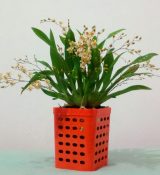Blooming Phalaenopsis Orchids
Author: Celeste Booth8 Comments
Blooming, Care and Culture, Growing Indoors, Growing Outdoors

Information about specific blooming conditions of Phalaenopsis orchids including ideal light and shade, temperature, humidity, air circulation, water, soil and planting beds, potting medium, feeding and fertilization.
- Light and Shade – Phalaenopsis do not require too much light to grow well. 1000-1500 foot-candles is the ideal light intensity required for Phalaenopsis. If grown in a windowsill, an east exposure proves to be the best. One must take care, though, not to burn the plant by allowing too much sunlight to shine directly on the plant. It is best to provide some shade, such as a sheer curtain, allowing perhaps a little more light to hit the plants from the beginning of December through the middle of February.
- Temperature – Phalaenopsis enjoy a fairly warm climate. The ideal night temperature is 62 to 65 degrees. and daytime temperature range of 70 to 80 degrees. Since this temperature range is similar to that of many homes, it makes an ideal house plant.
- Watering – Water your Phalaenopsis early in the morning. This insures complete water evaporation on the foliage as well as the crown by nightfall. Water with rain, distilled, or reverse-osmosis water as the mix approaches dryness. Never use water that has been softened by a water softener. Generally Phalaenopsis require watering about once every 4 to 7 days. Plants should never stand in water for long periods. Plants that stand in water or that are watered in the evening will develop bacterial or fungal rot. Pull out the plant label and see if there is any water residue on it. If not, it is time for watering. The weight of the pot can also help determine weather it needs watering or not. The pot should be fairly heavy after watering.
- Humidity – Phalaenopsis are of a monopodial growth without any pseudobulbs to help store moisture. For this reason, it is important to provide good humidity. 50-70% is considered ideal. However, if the plant is kept well watered, it will adapt to a lower humidity.
- Fertilizing – For tap or well water, use Grow More 20-10-20 fertilizer every other watering in the summer and every third watering in the winter. Fertilize at the rate of one-half teaspoon per gallon. Another highly recommended fertilizer is Green Jungle Orchid Food, especially formulated to work with rain, distilled, reverse osmosis water or water low in alkalinity. Fertilize with Green Jungle every time you water, all year round.
- Blooming – Commonly referred to as the “moth orchid”, Phalaenopsis are one of the longest blooming orchid genera producing flowers that last from 2 to 6 months before dropping. Phalaenopsis have also been known to bloom 2 to 3 times per year once they have reached a mature size. After it has flowered the first time, cut the stem just below the node where the first flower bloomed. From the top node a new flower stem should emerge within 2 months. If there is no response or the flower spike turns brown, cut it off near the base of the plant where it emerged.
- Potting – Because the Phalaenopsis is watered frequently, the potting breaks down about once per year. Spring or fall is considered the best time to repot because the temperature is generally mild, preventing shock. Use a medium grade orchid bark mix for plants in 5″ pots and above. We have found that New Zealand sphagnum moss works best for smaller Phalaenposis as it dries out more evenly.
8 Responses to “Blooming Phalaenopsis Orchids”
Leave a Reply


Ask an Expert
Questions about orchids?
Our experts love a challenge!
Photo of the Week
Submit your photo to be featured on the blog!
More Photo of the Week Winners
Submit Photo








phalaenopis orchids
We had a plant for seven years before it bloomed then it flowered late fall ,early spring and again in the following fall. Since it has not bloomed for the last three years. The pot was broken once and it repotted, losts of growth but no flowers, location and watering remain the same as from original purchase. Any tricks for a suttle change to bring it back into bloom.
thank you, Ed Hanson clareed@msn.com
@Ed Hanson – January through May are when Phalaenopsis orchid plants traditionally rebloom.
Phalaenopsis are easy to “save” provided their leaves are still present and not entirely limp. Winter to Spring is the best time to repot out of bloom phalaenopsis orchids regardless of their condition.
Gently wiggle the root ball out of the pots and brush off any old potting media. Place the roots into the smallest clay pot that will fit and fill it with either sphagnum moss or peat moss.
It is best to keep the potting media damp from now on.
Within a few weeks, a flush of new roots will emerge within the new media and a new leaf should be visibly growing. Later in the summer, a second leaf will grow and by the fall the plant will be ready for chilling. A few weeks of 50 degree nights and a mature healthy plant should be ready to initiate the next flower spike.
Another three months of spike and bud development and buds begin to open in January or February.
I received a phalaenopsis orchid from the florist two days ago. Within 12 hours most of the blooms(which were beautiful) were curled shut. They have remained that way for 24 hours. What is wrong? I gave the pot water and more light yesterday-no change.
What is the reason the stem becomes blackened at the top where the bloom was?
Can Phalaaenopsis be planted outdoors?
I had a few plants and I decided to buy another one. The problem with my other ones was that their leaves all fell off. Why does that happen?
Thank you for this info. I have several Orchids and I believe they are Phalaenopsis indoors. I water when I feel they may be dry due to time of yr. etc. I use a calendar to keep track of watering and food. My questions are:
The tip of the stem/leaf on one looks brown and dried out. does this mean not enuf water? Also I was told if the stem root is brown and dried if means too much sunlite. Not sure, but all sit at a window sill and face the east. summer I leave the blinds down and open till the sun as moved. Can you please advise.
Thank you
My orchid bloomed for several months and the flowers dropped off. Should I cut off the spike and keep feeding and watering it?